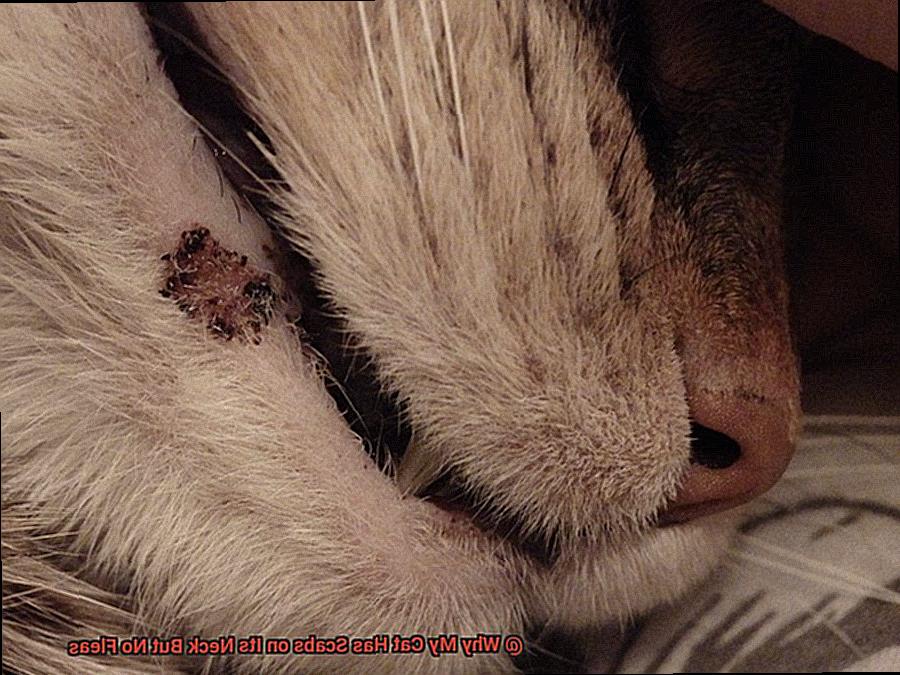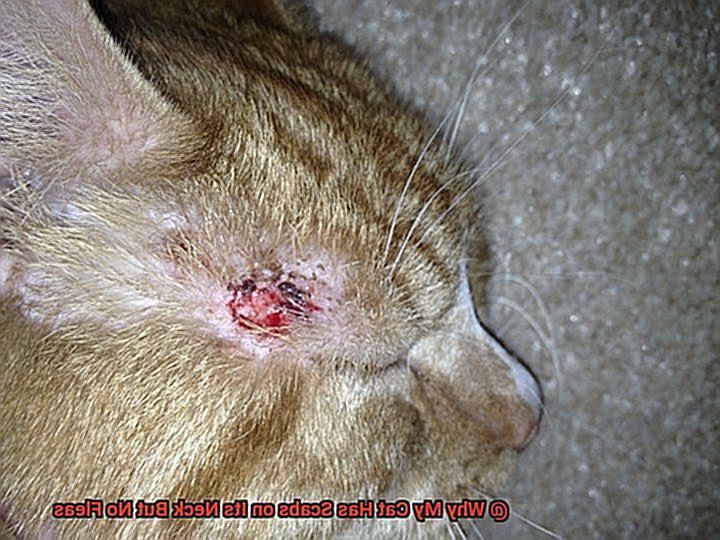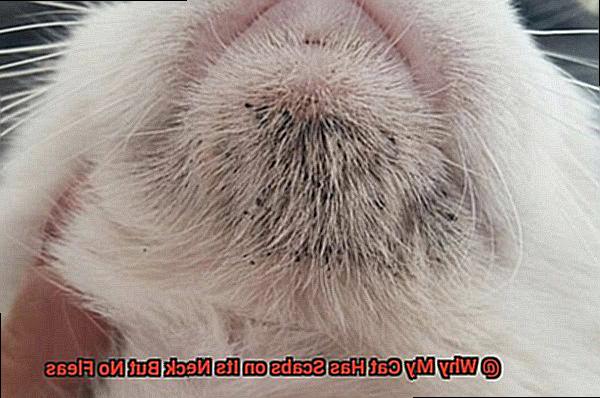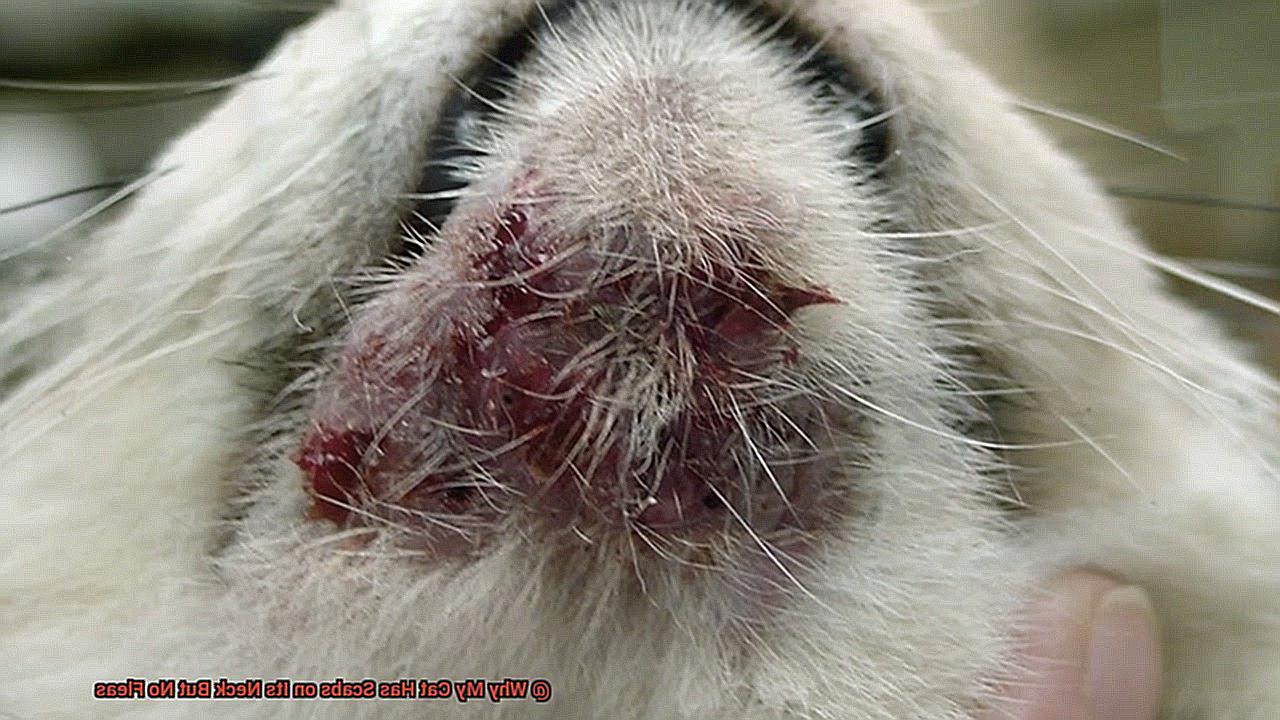If you’re a devoted cat parent, you know that your feline friend’s health is of utmost importance. That’s why it can be concerning to notice scabs on your cat’s neck. While fleas are often the first suspect, there are many other reasons why your kitty might have scabs but no fleas.
Don’t let the seemingly small issue of scabs fool you – they can actually indicate larger health problems. Allergies, parasites, ringworm, and more can all cause these pesky scabs to appear on your cat’s neck. As a responsible pet owner, it’s crucial to understand what could be causing them and how to properly care for your furry companion.
In this blog post, we’ll explore the potential causes behind your cat’s neck scabs in detail. From identifying symptoms to choosing the best treatments and preventative measures, we’ve got you covered. So settle in with your purring pal and get ready to become an expert on why your cat has those mysterious scabs on their neck.
What is Miliary Dermatitis?
It could be miliary dermatitis, also known as “scabby cat syndrome.” This skin condition is often mistaken for flea allergy dermatitis, but it has many other potential causes, such as allergies, infections, hormonal imbalances, and stress.

Miliary dermatitis is a common skin condition in cats that can cause discomfort and distress. The symptoms are easy to spot, with small, raised scabs or bumps appearing around the neck, head, and back. In severe cases, cats may experience hair loss and develop open sores on their skin.
If you suspect that your cat has miliary dermatitis, it’s essential to seek veterinary care right away. Your veterinarian will perform a physical examination and conduct diagnostic tests to determine the underlying cause of the condition. Once the underlying cause has been identified, they will recommend an appropriate treatment plan.
Treatment for miliary dermatitis may include medication to treat infections or inflammation, dietary changes to address food allergies, or even behavioral modifications to reduce stress. By working together with your vet to identify and address the root cause of the condition, you can help your furry friend find relief and improve their overall quality of life.
In conclusion, if you notice small scabs or bumps on your cat’s skin, don’t jump to conclusions about flea allergy dermatitis. It could be miliary dermatitis caused by a variety of other factors. Seek veterinary care right away for an accurate diagnosis and proper treatment plan to help your furry friend feel better soon.
Causes of Miliary Dermatitis
If your furry feline friend is scratching their neck and developing tiny bumps or scabs, it could be a sign of miliary dermatitis, also known as “scabby cat syndrome”. This condition can cause discomfort and irritation to cats, making them feel itchy and uncomfortable.
So, what are the causes of this skin condition? One of the most common culprits is allergies. Allergies in cats can be triggered by a variety of factors such as food, flea bites, or environmental irritants like pollen or dust mites. Identifying the specific trigger may require allergy testing.
Hormonal imbalances can also lead to miliary dermatitis in cats. Conditions such as hyperthyroidism or Cushing’s disease can cause skin irritation and scabbing. Parasitic infections like mites or lice, bacterial or fungal infections, and autoimmune disorders are other possible causes that can cause skin irritation and scabbing.
Stress may also play a role in the development of miliary dermatitis in cats. Over-grooming due to stress can irritate the skin and cause scabbing. Identifying and addressing any underlying stressors in the cat’s environment can help reduce the risk of future outbreaks.
It’s crucial to work with a veterinarian to determine the underlying cause of miliary dermatitis in your cat so that appropriate treatment can be provided. Treatment options may include medications to manage symptoms such as itching and inflammation, as well as addressing any underlying medical conditions contributing to the problem.
If you suspect your cat may have miliary dermatitis, don’t hesitate to seek veterinary care for an accurate diagnosis and treatment plan.
Symptoms of Miliary Dermatitis
Miliary dermatitis, also known as scabby cat syndrome, is a pesky skin condition that can make your feline friend feel quite miserable. If you’ve noticed your cat has small scabs on their neck or head, it may be a sign of miliary dermatitis.
One of the most noticeable symptoms of this condition is intense itching. Your cat may scratch or bite at the affected area, which can lead to hair loss and the development of scabs on their neck, head, and back. In some cases, you may also notice redness and inflammation of the skin, as well as crusty lesions.
So what causes miliary dermatitis? It’s an allergic reaction to something in your cat’s environment. While flea bites are a common culprit, food allergies and airborne allergens can also trigger this condition. That’s why it’s crucial to take your furry friend to a veterinarian for a proper diagnosis.

Treatment options depend on the underlying cause of the condition. Your vet may recommend identifying and removing the allergen from your cat’s environment, changing their diet to address food allergies, or administering medications such as corticosteroids or antihistamines to alleviate symptoms. In severe cases, antibiotics may be necessary to treat any secondary bacterial infections.
It’s important to note that not all cats with scabs on their neck have fleas. Other underlying causes must be considered and addressed to ensure proper treatment and management of the condition.

In conclusion, if you suspect your cat has miliary dermatitis, don’t hesitate to take them to the vet for a proper diagnosis and treatment plan. With proper care and attention, you can help soothe your cat’s discomfort and improve their overall health and well-being.
How to Diagnose Miliary Dermatitis
Miliary dermatitis, or “scabby cat syndrome,” is a bothersome skin condition that can cause cats to experience itching, hair loss, and the development of small scabs. These scabs are often seen on the neck, back, and tail, and can be caused by a variety of factors such as parasites, allergies, and stress. If you notice your feline friend exhibiting any of these symptoms, it is important to seek veterinary care to properly diagnose and treat the condition.
Recognizing the Symptoms:

Miliary dermatitis can manifest itself in a variety of ways, but the most common symptoms include raised bumps on the skin, excessive scratching, hair loss, and crusty scabs that can become infected with bacteria. If you see your cat exhibiting any of these signs, it is important to take them to the vet for a proper diagnosis.
Physical Examination:
To diagnose miliary dermatitis, a veterinarian will typically perform a physical examination of the cat’s skin. This may involve searching for signs of inflammation, such as redness or swelling, and taking a skin scraping to check for mites or other parasites. The vet may also ask about the cat’s diet and any recent changes in their environment to help identify potential allergens.
Identifying the Cause:
Miliary dermatitis can have many underlying causes such as food allergies, environmental irritants, bacterial or fungal infections or hormonal imbalances. Once fleas have been ruled out as the cause of the scabs, additional tests like allergy testing or an elimination diet may be recommended to pinpoint the specific trigger behind your cat’s condition.
Treatment Options:
Treatment for miliary dermatitis will depend on its underlying cause. For instance, if food allergies are causing the issue, changing your cat’s diet may be necessary. Other treatment options include topical or oral medications to address infections or inflammation and behavioral modifications to reduce stress levels in your cat. In some cases, a combination of treatments may be necessary to provide adequate relief.
Preventing Future Outbreaks:
Miliary dermatitis can be an ongoing condition, necessitating consistent monitoring and management to prevent future flare-ups. Regular check-ups with a veterinarian and diligent flea prevention measures are also critical in preventing future outbreaks.

Treatment Options for Miliary Dermatitis
Fortunately, there are several treatment options available to alleviate symptoms and manage the underlying cause of the condition.

One effective treatment option for miliary dermatitis is identifying possible allergens that may be causing skin irritation. This involves a process of elimination through trial and error to determine what substances may be causing the issue. Common allergens include certain types of food, grooming products, or environmental factors such as pollen or dust.
Another effective option is the use of medicated shampoos or ointments containing corticosteroids, antibiotics, or antifungal agents. These treatments can help alleviate symptoms and promote healing. It’s essential to follow the instructions carefully and use these products only as directed by a veterinarian.
In some cases, oral medications like antihistamines, steroids, or antibiotics may be necessary depending on the underlying cause of the condition. It’s crucial to consult with a veterinarian before administering any medication to your cat.
It’s essential to note that while treatment options can be effective in managing miliary dermatitis, it’s not always possible to completely cure the condition. Regular monitoring and management of symptoms may be necessary to keep the condition under control and prevent complications.
Dietary Changes to Address Food Allergies
Don’t fret. Food allergies could be the culprit, but there’s a way out. Dietary changes can be an effective solution to alleviate these symptoms.
Food allergies occur when a cat’s immune system reacts negatively to certain proteins found in their food. To address this, it’s important to identify the specific protein causing the allergy and eliminate it from the cat’s diet. Sounds daunting, right? But hold on; there’s more than one way to skin a cat. One way is by switching to a hypoallergenic diet that contains novel proteins, such as duck or venison, that your cat has not been exposed to before.
Now, don’t go full steam ahead. Remember, dietary changes should be made gradually to avoid upsetting your cat’s digestive system. In addition, incorporating supplements such as omega-3 fatty acids and probiotics can help improve skin health and reduce inflammation caused by allergies. You can add these supplements to your cat’s diet through specially formulated foods or give them as standalone supplements.
Before making any significant dietary changes, it’s crucial to consult with a veterinarian. They can perform tests and provide guidance on the best course of action for addressing food allergies and improving your cat’s overall health. Your vet can also recommend a diet suitable for your cat’s needs and ensure that the transition process goes smoothly.
In conclusion, dietary changes can be an effective way to address food allergies in cats and alleviate skin irritation and scabbing.
Behavioral Modifications to Reduce Stress
Unfortunately, stress can sometimes take a toll on your kitty’s well-being, leading to the development of scabs on their neck. But don’t worry – there are ways you can help reduce your cat’s stress levels through behavioral modifications.
One of the primary ways to reduce stress in cats is by providing them with adequate physical and mental stimulation. This can be as simple as playing interactive games with them or investing in puzzle feeders and scratching posts. Regular exercise is also crucial in reducing anxiety levels in cats.
Creating a safe and peaceful environment for your cat is another important aspect of reducing stress. Your feline friend should have a quiet and comfortable space to rest and sleep, with access to fresh water, clean litter boxes, and healthy food.
Identifying the source of your cat’s stress is also crucial. It may be necessary to limit exposure to other animals or loud noises, establish a predictable routine, or seek help from a veterinarian or animal behaviorist.
Prevention Tips for Miliary Dermatitis
If so, you may want to learn how to prevent miliary dermatitis, a skin condition that can cause scabs on your cat’s neck, back, and tail. Here are five tips to help you prevent this frustrating condition.
Feed your cat a well-balanced diet
Proper nutrition is key to keeping your cat healthy. A diet that is high in essential fatty acids, such as omega-3 and omega-6, can help improve skin health and reduce the likelihood of developing skin irritations and allergies. Talk to your vet about which foods are best for your cat’s needs.
Groom your cat regularly
Regular grooming is essential for maintaining your cat’s skin health. Brushing helps remove any loose hair or debris, promotes healthy circulation, and keeps the coat looking shiny and healthy. Additionally, bathing your cat with a gentle, hypoallergenic shampoo can help soothe any existing irritations and prevent new ones from developing.
Keep your cat’s environment clean
A clean environment is crucial for preventing miliary dermatitis. Keep litter boxes clean and use non-toxic cleaning products around the home to avoid any potential irritants. Dust and vacuum regularly to reduce allergens in the air.
Keep your cat indoors

Fleas are a common cause of miliary dermatitis, so it’s important to keep your cat indoors as much as possible, especially during peak flea season. Use flea prevention products recommended by your vet and keep an eye out for signs of fleas or other pests.
Regular check-ups with your vet
Catching any skin issues early on is crucial for preventing miliary dermatitis. Your vet can provide recommendations for preventative measures specific to your cat’s individual needs and monitor any potential skin problems. Be sure to schedule regular check-ups at least once a year.
By following these prevention tips, you can help keep your cat comfortable and healthy while minimizing the occurrence of this frustrating condition. Remember, prevention is key when it comes to miliary dermatitis.
Kw3WgJsGW44″ >
Conclusion
In summary, scabs on your feline’s neck can be a troubling sight, but don’t jump to conclusions and assume it’s always fleas. Miliary dermatitis, which is also known as scabby cat syndrome, is a common skin condition that can cause discomfort and distress for your furry friend. This condition is characterized by small raised scabs or bumps around the neck, head, and back.
Numerous factors can trigger miliary dermatitis in cats including allergies, infections, hormonal imbalances, and stress. Therefore, prompt veterinary care is essential to diagnose and treat the underlying cause of this condition accurately.
Your vet will perform a thorough physical examination and conduct diagnostic tests to determine the root cause of miliary dermatitis. Treatment options vary depending on the underlying cause of the condition. These may include medication to treat infections or inflammation, dietary changes to address food allergies or behavioral modifications to reduce your cat’s stress levels.
Prevention is always better than cure when it comes to miliary dermatitis. Feeding your cat a well-balanced diet, regular grooming sessions, maintaining a clean environment free from fleas are some ways you can prevent this frustrating condition from occurring in the first place. Scheduling regular check-ups with your vet will also help detect any potential issues early on before they escalate into something more severe.
Remember that early detection and proper treatment are critical in improving your cat’s overall quality of life.







